Here is a little promotional video I made for my 2018 Cabaret of Dangerous Ideas show: “Is Astronaut Food the Future?”
See you on 20th August at 8.10pm!
Here is a little promotional video I made for my 2018 Cabaret of Dangerous Ideas show: “Is Astronaut Food the Future?”
See you on 20th August at 8.10pm!
Absolutely thrilled to be announcing my upcoming Edinburgh Fringe show: “Is Astronaut Food the Future?”
The event is part of the Cabaret of Dangerous Ideas series (CODI), which is a joint Beltane Public Engagement Network and Fair Pley production. This is my third time at the Fringe, you might even rememner the 2016 show “Let Big Brother Watch!” and last year’s collaboration with the amazing Pippa Goldschmidt on “Outer Space – The Next Empire?”
So this year we will be talking all things Food and (Outer) Space, from consumables sent “up there”, “space microwaves”, baking bread and growing salad on International Space Station and Earth Observation technologies controlling global food production of the future.
To find out more why this matters, here is a little interview I did for the CoDI Blog.
Finally, speaking of freeze drying, there might be some interesting samples to taste…
Though the plan is to have as much fun as possible, there are interesting questions surrounding food production, nutrition science and the role of “consumers”, PS: that is you and me, in all of this.
Most importantly, I will be wanting to hear your opinions about what high-tech might do to food standards, quality and also is end in sight for food poverty.
If you want to find out how this links to my research and teaching, I have written a Teaching Matters blog: CoDI: Is Astronaut Food the Future?
So, join me on 20th August at 8.10pm in the Stand’s New Town Theatre (George Street; Fringe Venue 7) to have your say about having astronaut food for dinner!
More info and tickets: www.bit.ly/IsAstronautFoodTheFuture
Kindly supported by the Student Development Office at the School of Social and Political Science.
This is a slightly late update on another outreach project I was involved with this Summer. Between 10th-14th July 2016, “Heavy Flavour – Quo Vadis?” workshop was organised by the Particle Physics Group, School of Physics and Astronomy, The University of Edinburgh, at the Ardbeg Distillery on Islay.
The aim of the workshop was to the future direction of research for heavy flavour physics, so-called as it involves the study of the heavy beauty and charm quarks that are produced in large numbers at the CERN Large Hadron Collider.
In parallel with the workshop, a series of public outreach events were held at Bowmore High School between 12th-14th July 2016, organised on behalf of the Particle Physics Group by Alan Walker, Director of Particle Physics for Scottish Schools (PP4SS), and the local Science teacher, Russell Pollock. This comprised of three joint exhibitions: Particle Physics for Scottish Schools Exhibition, From Maxwell to Higgs Exhibition (Royal Society Edinburgh) and I-SAT: Islay Space and Astronomy Tour.
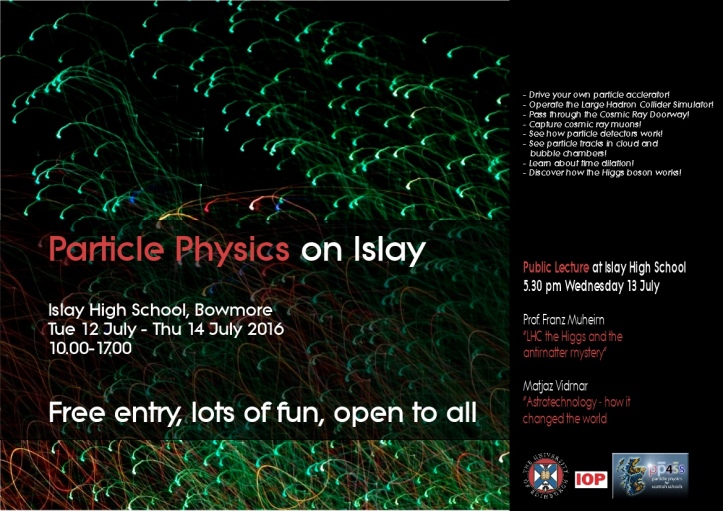
The latter, Islay Space and Astronomy Tour (I-SAT), was a new invited project I designed specifically for this event on the basis of an IoP in Scotland Public Engagement Grant. In particular, I was asked to develop an interactive display related to my research, which concerns the applications of basic research and innovation partnerships between scientists and local entrepreneurs in the Space Industry in Scotland and to give a talk about science, technology and innovation in Astronomy and Space Science at the evening public session.
The display included a rolling loop explaining key features and current finding of my research and a selection of relevant info-sheets produced by Science and Technology facilities Council (STFC) and Institute of Physics (IoP).
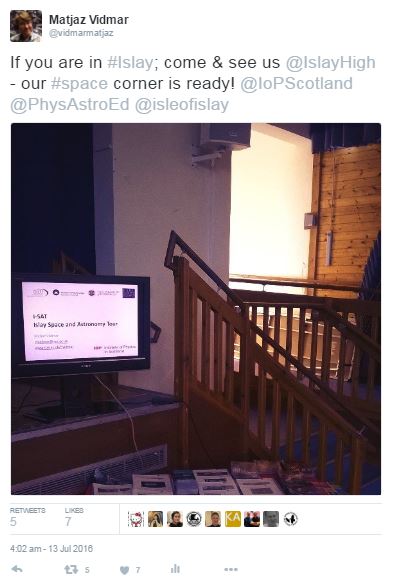
I was near the display for most of the time exhibition was open and have regularly given short (15min) informal talks small groups of people to explain my work further.
It IS Rocket Science! – Building Scotland’s Space Sector
Building on detailed micro-level studies of innovation process my research suggests that the further development of Scottish Space Sector rests on matching the right people and institutions, who can then trade resources, knowledge and skills
Hence, I am using Social Network Analysis to map out the knowledge network(s) of the Space Industry in Scotland in order to identify its key systemic characteristics and outline the contours of the interactions (knowledge flows) between new product development (NPD) processes and its environment are the key for understanding which external factors most significantly influence the success of commercialisation of emerging Space technologies.
However, illuminating this network and characterising its effects is not trivial – after all, who said it was not rocket science?
The series of events also included a public session with two presentations, one by the organiser of the workshop, Prof Franz Muheim, on “Higgs Bosons, Antimatter and all that” and the other my own on “Astrotechnology – and how it changed the World”. The event was well attended and well received by the local community (see below).
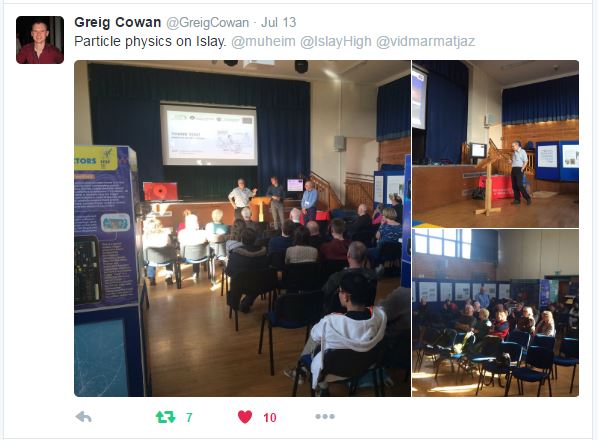
Astrotechnology – and How it Changed the World?
Astronomy research is both driving the technological advances as well as being shaped by them. From ancient telescopes to modern infra-red detectors simulations, the practice of Astronomy is very much rooted in physical objects – most of them located down here on Earth!
Using an example of such an object, an ordinary DSLR camera, this talk will afford a fly-by tour of the key astronomical technologies, how did they come about and what did they do for the science as well as for the society. We will examine the way Space innovation is allowing us to see the past and the future, the distant and the invisible, to experience reality well beyond our imagination and then emerge in the world to change it for the better.
What have the Space ever done for us, again?
Though our initial estimate was to attract about 300 visitors to the exhibition and the evening event combined, this turned out to be relatively ambitious, in particular as the events happen to coincide with unusually good weather for Islay, which led to many (in particular younger) audiences to try and spend more time outdoors. In the end, we have had approximately 100 unique visitors to the events in total, the evening talk being attended by around 30 people. Given the small population on Islay (around 3000 total), this is still a significant turnout.
More importantly, the visitors were very interested in the events and thought them to be of high quality. Some commented:
“Great interactive exhibition.”
“Great initiative – never had anything like that on islands when I grew up.”
“When are you coming back?”
Importantly, we engaged with several groups of high school children, who are thinking about studying science, and have said that this positive experience motivated them even more. Furthermore, noticing the event activities on Twitter (announcements alone reached over 6,700 impressions and 115 engagements), some were already advocating future locations to visit, which we would be more than happy to follow up!
More information (including more photos) about the activities on Islay can be found
Finally, none of this would be possible without financial support from the IoP in Scotland Public Engagement Grant and the Particle Physics Group at the School of Physics and Astronomy, and the generous hospitality of the Islay High School, Bowmore.
I will be running an interactive show at Edinburgh Fringe 2016 Cabaret of Dangerous Ideas challenging what people think about satellite images and the ability or will of “others” to spy on your back yard…
In 1984 George Orwell wrote:
By comparison with that existing today, all the tyrannies of the past were half-hearted and inefficient. […]
Part of the reason for this was that in the past no government had the power to keep its citizens under constant surveillance. The invention of print, however, made it easier to manipulate public opinion, and the film and the radio carried the process further. With the development of television, and the technical advance which made it possible to receive and transmit simultaneously on the same instrument, private life came to an end. Every citizen, or at least every citizen important enough to be worth watching, could be kept for twenty-four hours a day under the eyes of the police and in the sound of official propaganda, with all other channels of communication closed. The possibility of enforcing not only complete obedience to the will of the State, but complete uniformity of opinion on all subjects, now existed for the first time.
By the Orwellian account above, advancing technology is, if left unchecked, a very real threat to human rights and democracy. As mentioned in my Cabaret of Dangerous Ideas show brief (bit.ly/CoDI-Satellites), satellite images now cover every inch of the world. Which leads me to the question, is this an invasion of privacy and
a major challenge to human rights, or is Big Brother really still quite controlled and tame? Is it fair to say that the majority of satellite images benefit our daily lives more than they intrude? And what is the scale and shape of their intrusion?
People’s concerns regarding the intrusive “eyes in the sky” turning to “spy” on our back yards, is what interest me. The event will explore these concerns. I hope to explain some of the technical set up of satellite observation of the Earth and the way data from “Earth Observation” is used. Such usage includes various applications related to management of the environment, natural resources, energy generation and consumption, public transport networks.
We will look into both the current cutting edge developments in Space Science, as well as technological applications and the impact they are generating in various contexts of our daily lives. Here, I will draw heavily on my research of innovation and entrepreneurship in the Space Sector. This relates scientific endeavour, technological prowess and entrepreneurial spirit, to generate an advanced Space-enabled economy for the future.
Though I am a Physicist by training, specialising in Astronomical Instrumentation, I am a postgraduate (PhD) student in Science, Technology and Innovation Studies (stis.ed.ac.uk). I now primarily research innovation and business incubation in Space Technologies. Examples include satellites and ground-based telescopes. My research is centred on how knowledge is passed from basic research (i.e. science and engineering) into small firms all around Scotland. These firms, in turn, provide products and services to make space technology. They then use the data generated to make our lives that bit easier and richer.
Fear not! CoDI’s wonderful compère, comedian Susan Morrison, will be sure to keep the entertainment coming. We may even have special surprise in store for you – a special guest of sorts!

Furthermore I am no stranger to a bit of fun. I have done some similarly interesting stuff before! I have previously performed stand up in Bright Club (bit.ly/Bright-Club-First-Degree). Additionally I am a science communicator at the Royal Observatory Edinburgh Visitor Centre. Here I am speaking to a variety of audiences about Astronomy and the emerging technologies. I assist in the running of the Particle Physics for Scottish Schools (PP4SS, UoE); assist with the delivery of Sci-Fun (UoE), Physics in the Field and Lab in a Lorry projects (IOP); and organise one off events (e.g. Falkirk and Borders Science Festivals). Additionally, I regularly deliver talks to Astronomy societies across Scotland.
The show takes place on Monday 15th August, Stand in the Square (Venue 372), 3-4pm, £8 (£6)
Purchase tickets at: bit.ly/CoDI-LBBW-Tickets
This event is part of the Cabaret of Dangerous Ideas series (codi.beltanenetwork.org). It is a Beltane Network, Fair Play and Stand co-production for Edinburgh Fringe Festival 2016. Special thanks to Graduate School of the School of Social and Political Science, University of Edinburgh and the Institute of Physics in Scotland (iopscotland.org) for financially supporting this show.
This is from a special blog about my CoDI show, which can also be found here: 25 Days of CoDI: Day 12
This is a belatedly late post about some of my (early) research findings – and my efforts to disseminate them.
This is build around Phase 1 of my research into the facilitation of technology transfer from basic research into high-tech industry, which is (hopefully) leading to overall economic growth and prosperity.
I am focusing on the Space Sector, the historic development of which is in its 3rd phase, sometimes referred to as the “New Space”, – after the initial state monopoly (1st phase) and the technology being commercialised by large multinational corporations (2nd phase), it is now being democratised through innovation and entrepreneurship as the (previously complex and expensive hardware becomes smaller, more standardised and cheaper (Space IGS, 2010). In the context of this transition and growth of the sector, there is a government target of increasing the UK share of global Space market from 7% to 10% by 2030 (Space IGS, 2010).
For small and medium size enterprises (SMEs) – which are the subject of my research – this is also denoting a transition in SMEs from “technology-push” to “market-pull” new product development (NPD) orientation, based on a shift from “supplying” to larger companies to “selling” to end customers/users, which is also moving from “mass-manufacturing” to developing Complex Products and Services (CoPS) (Hobday, 1998) and vertical value chain integration.
In order to help facilitate technology transfer at this transition point – one of the objective of my research – a key link between the systemic understanding of the sector and the innovation processes and practices in companies must be established. Given the prevalence of network research – which is at the core of Innovation studies both at macro as well as micro level (Freeman, 1991), due the fact that it covers the crucial aspect of knowledge commercialisation, namely interaction – this is an obvious choice to bridge the two.
In particular I am using ego-centric Social Network Analysis (SNA) (Scott, 1988; Giuliani, 2007) to plot the business network for each of the three studied companies (see table above). This is based on a survey-style questionnaire, with multiple-choice answers, but options for other (more expanded) answers as well. This enabled me a comprehensive analysis of the knowledge network, in particular the flows of knowledge and a qualitative analysis of the NPD process, by examining the specific “innovation moments” (i.e. points at which decisions about developing an innovation into a product take place) (Edwards et. al., 2000), the role external partners play in those instances and how the differences in companies’ network make-up affect the creation of new products (and vice-versa).
Presently, the study is in its pilot incarnation, focusing on three case studies, carefully selected to represent key elements of the population of the field (upstream /downstream; hardware/software; start-up/spin-off; “Classical”/”New Space”; products/services), i.e. a set of typical cases (Yin, 2009), as summarised here:
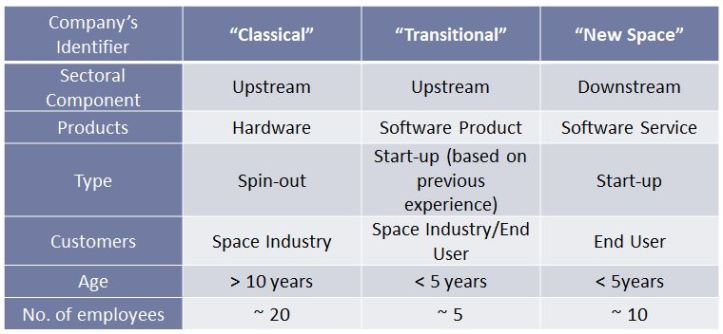
In short, these are the key findings so far:
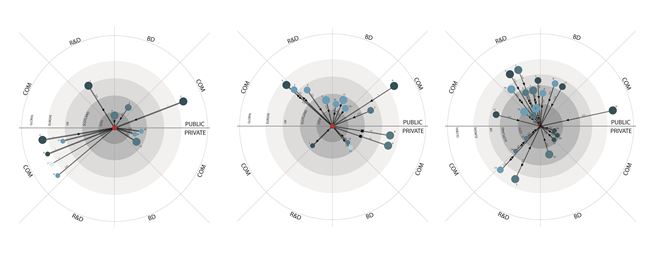
Of course, these are only preliminary observations and substantial further research is being planned to further this work, including expanding the study to analyse all Scottish Space Sector companies.
If you are interested in a more full account of my research click through for the full paper presented at Reinventing Space 2015 conference (Oxford, 9th-13th November 2015)
Here is also a photo of my poster (from SUPA Cormack Meeting 2015):
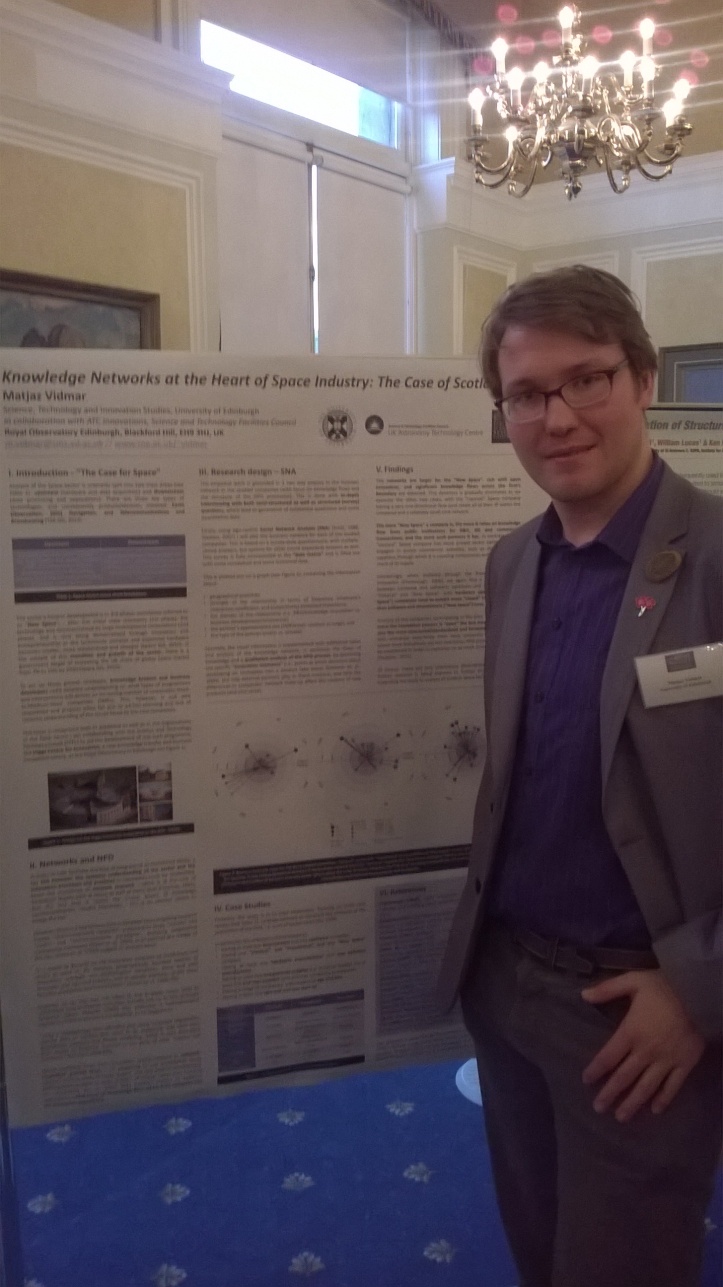
Hello, finally a “proper” post after a while!
In fact, this post may not be so “proper” after all, as it is only marking a start of a short series about impact evaluation, an important part of my research in science, technology and innovation.
The plan is to have four posts (ER1-4): (1) an introduction to my research in (impact) evaluation; (2) an exploration of key themes in evaluation research; (3) an analysis of the cost benefit analysis model, dominant in the policy sphere; and (4) an outline of a new methodology -Quantified Correlated Impacts (QCI).
This is very much work in progress so, perhaps, more posts will appear later on and I would very much like to hear your comments on any of it!
Importantly, this effort is part of 2015 incarnation of Evaluation Research Methods course, a postgraduate course in the School of Social and Political Science at the University of Edinburgh.
Please, do spare a minute or two and have a look at a host of other contributions at our collective blog and follow our Twitter discussion marked with: #evalres15.
And here is another! Video about my research, that is.
I have now started the Student Research Films (SRF) initiative, a video series of Edinburgh University students briefly (should be under 1min) talking about our different research projects. (If interested to take part, check out the resources page!)
The idea came from all the video work I have done recently and the Research in a Nutshell series, a similar initiative for academics (1min videos about their research). In particular, I found these 60 second introductions very useful when meeting new staff, looking for information about my interests and seeking advice about my research.
As part of the Innovative Learning Week 2015 I got some funding to put together a small workshop to exchange ideas, present the template to other students and challenge us all to make a video each (there were also two prizes for the best entries – congratulations to Nurun and Alastair!). We got five videos in total in this first batch including mine…
I am very grateful to Siri Rodnes, Bob Fisher, Alyssa Newman and Helene Frossling Mattsson for all their help and enthusiasm for this project.
We are hoping to grow this initiative over the years, so if anyone seeing this is interested, do have a look at the project page and/or get in touch with me!
Hello!
Another video of mine is out, this time about why do I do my research at the University of Edinburgh.
This is part of the “The University of Edinburgh is My Perfect Match Because…” Video Challenge.
There are more videos from the Challenge available at EUSA YouTube Channel.